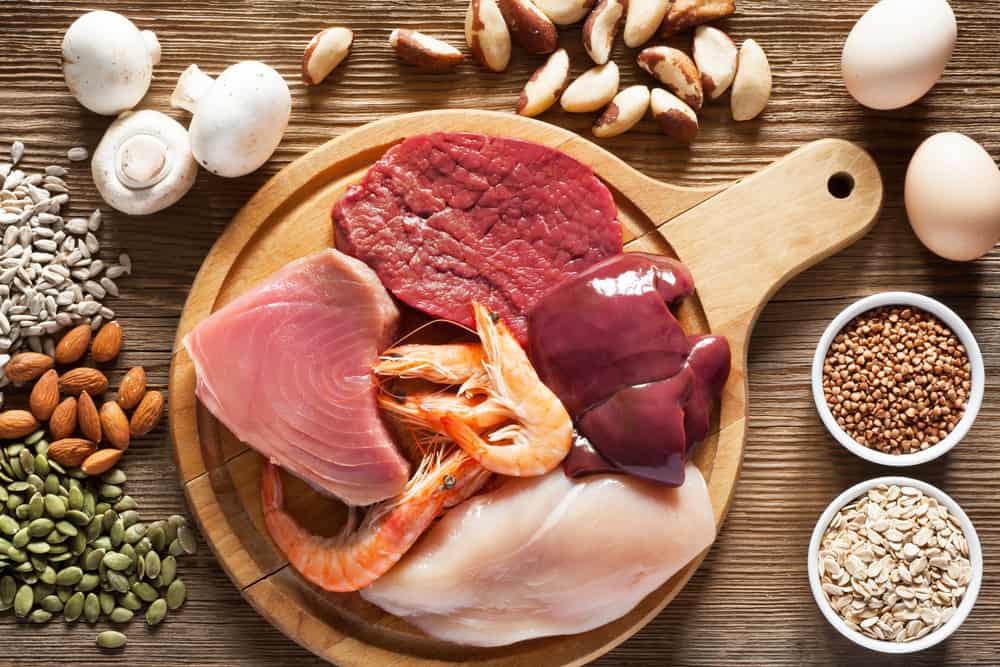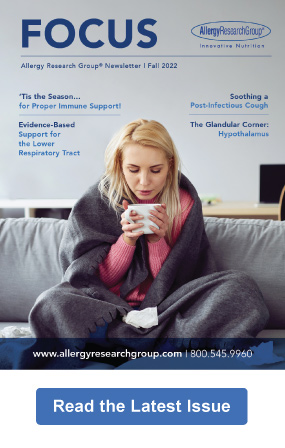Share this post
Guarding against environmental toxins
Selenium is a mineral with remarkable antioxidant benefits. Although it is needed only in small amounts, selenium is vital for thyroid, reproductive and immune function, and for protecting the brain, heart, and kidneys against environmental toxins.[1]
Selenium is like a battery that operates within 25 different selenium-containing proteins (selenoproteins) in mammalian cells.[2] Some selenoproteins are enzymes that catalyze redox (reduction/oxidation) reactions, while others help transport selenium to target tissues. The most important redox managers in human cells are enzymes known as glutathione peroxidase (GPx) and thioredoxin reductase (TrxR).[2] There are eight forms of GPx in human cells, and each has slightly different actions. GPx1, for example, uses glutathione and converts hydrogen peroxide to water, thereby keeping the peroxide from damaging cells. These enzymes cannot function without selenium.
Although it is needed only in small amounts, selenium is vital for thyroid, reproductive and immune function, and for protecting the brain, heart, and kidneys against environmental toxins.
Science is beginning to reveal the many ways in which selenium keeps the redox machinery rocking along. These include:
Protection against heavy metals
Selenium helps protect against the toxic effects of heavy metal exposure. No, we’re not talking about loud music here (although some of us would like to protect against that too!). The term heavy metal refers to any metallic chemical element that has a high density relative to water and is toxic or poisonous at low concentrations.[3],[4] Examples of heavy metals include mercury, cadmium, arsenic, and lead, which are among the 10 substances most dangerous to public health.[5]
Heavy metal exposure can occur through many different routes, including via the water we drink, foods we eat, air we breathe, and substances that contact our skin. A significant amount of the damage associated with heavy metal-induced toxicity is due to the production of reactive oxygen species, resulting in tissue damage and adverse health effects. The related health issues may include cardiovascular disorders, nerve and brain damage, poor bone growth, kidney injury, and an increased risk of cancer and diabetes.[6]
Methylmercury (MeHg), prevalent in the seafood we eat, and elemental mercury (Hg0), found in dental amalgams, has been studied in great detail. It is toxic to the nerves, kidneys, immune system, and gastrointestinal tract. [4],[7] The toxic effects of mercury are in part attributed to its sequestration of selenium and the irreversible inhibition of selenoproteins (such as TrxR),[8] especially those required to prevent and/or reverse oxidative damage in the brain, one of the fatty tissues in which mercury readily accumulates.[9],[10]
Selenium mitigates the toxic effects of environmental mercury, lead, arsenic, and cadmium by forming an insoluble complex (chelate) with these metals and reversing the oxidative damage.
Selenium mitigates the toxic effects of environmental mercury, lead, arsenic, and cadmium by forming an insoluble complex (chelate) with these metals and reversing the oxidative damage. [10],[11],[12],[13],[14] Maintaining a steady supply of selenium is important, because low plasma selenium levels exacerbate the health risks associated with mercury and other heavy metals.[15] In mercury-exposed residents of Wanshan, China, for instance, supplemental selenium decreased oxidative damage, reduced the mercury burden in the body, and increased mercury excretion.[16]
Selenium also safeguards against organic pollutants and toxicants such as herbicides,[17] bisphenol A (BPA),[18] and mycotoxins (mold toxins) such as ochratoxin A.[19],[20] Last but not least, animal studies have shown that selenium supplementation could prevent the oxidative stress and cardiovascular inflammation induced by air pollution particulates (PM2.5).[21]
Selenium’s synergy with other antioxidants and nutrients
The metabolism and subsequent excretion of heavy metals from the body depends on the presence of antioxidants. Antioxidants mitigate the harmful effects of free radicals.[5] Glutathione is of primary importance as an intracellular antioxidant, as in addition to being essential for cellular energy production and protection from oxidative damage, it also complexes with metals such as mercury and transports them out of cell and the body.[22],[23] GPx, one of the enzymes requiring selenium, facilitates the reaction between glutathione and hydrogen peroxide, generating oxidized glutathione and water.[24] The oxidized glutathione is then recycled back to reduced glutathione via another enzyme, glutathione reductase.
Studies show that selenium also works alongside antioxidant nutrients such as vitamins E and C, resveratrol, and isothiocyanates (sulforaphane) to reduce heavy metal toxicity.[25] A combination of sulforaphane and selenium has been shown to provide greater protection against oxidative injury than either ingredient alone.[26],[27] Sulforaphane is a type of organic compound known as isothiocyanate found in all those healthy cruciferous vegetables: broccoli, cabbage, kale, collard greens, cauliflower, bok choy, and Brussels sprouts.[28] Sulforaphane works through Nrf2,[29] a protein that masterminds cellular responses to oxidative stress, upregulating enzymes necessary for glutathione recycling.[30] Nrf2 turns on the first step of gene expression of the redox managers TrxR-1 and GPx2, which utilize selenium and restore the redox balance – as long as enough selenium is around.[31]
Selenium and coenzyme Q10 (CoQ10), a fat-soluble antioxidant, work together to support heart health.[32] A prospective randomized double-blind placebo-controlled trial in Sweden showed a significant long-term reduction of cardiovascular mortality in elderly individuals supplemented with both CoQ10 (200 mg per day) and selenium (200 mcg per day) for up to five years, compared with a placebo group.[30] Remarkably, the health benefits of selenium and CoQ10 were still apparent 12 years later.[33] Further analysis showed that selenium supplementation was cardio-protective in participants with low serum selenium concentrations at the start of the study, while there was no effect of supplementation in those with adequate selenium (defined as a serum selenium level greater than 85 mcg/L).[34]
How much selenium do we need?
The U.S. recommended dietary allowance (RDA) of selenium for adults is 55 mcg (micrograms) per day.[35] The main dietary sources of selenium are Brazil nuts, seafood, meat, poultry, fish, eggs, and whole-grain bread.[33] Fruits and vegetables generally are low in selenium. If you – or someone you love – is on a vegan, gluten-free, or ketogenic diet, take note: such diets often provide suboptimal levels of selenium.[36],[37],[38],[39],[40]
Dietary supplementation of selenium at a dose of 200 mcg per day is generally considered safe and adequate for adults of average weight consuming a typical American diet.[41] Excessive selenium intakes are not beneficial, and may even produce harmful effects over the long term, including a possible increased risk of diabetes and amyotrophic lateral sclerosis (ALS).[42]
Summary
Selenium has a powerful role as a detox/redox agent. It helps protect the health of the body systemically against oxidative damage caused by a variety of environmental pollutants. Selenium supplementation at modest levels helps replenish selenium stores in the event of suboptimal diets and common environmental exposures, including heavy metals like mercury.
Click here to see References
[1] Zoidis E, et al. Selenium-dependent antioxidant enzymes: actions and properties of selenoproteins. Antioxidants (Basel). 2018 May 14;7(5).
[2] Schweizer U, Fradejas-Villar N. Why 21? The significance of selenoproteins for human health revealed by inborn errors of metabolism. FASEB J. 2016 Nov;30(11):3669-81.
[3] Tchounwou PB, et al. Heavy metal toxicity and the environment. EXS. 2012;101:133-64.
[4] Jan AT, et al. Heavy metals and human health: mechanistic insight into toxicity and counter defense system of antioxidants. Int J Mol Sci. 2015 Dec 10;16(12):29592-630.
[5] World Health Organization (WHO). International Program on Chemical Safety. Ten chemicals of major public health concern [Internet]. Geneva (Switzerland): WHO; 2010 [cited August 6, 2018]. Available from: http://www.who.int/ipcs/assessment/public_health/chemicals_phc/en/
[6] Rehman K, Fatima F, et al. Prevalence of exposure of heavy metals and their impact on health consequences. J Cell Biochem. 2018 Jan;119(1):157-84.
[7] Bjørklund G, Dadar M, et al. The toxicology of mercury: Current research and emerging trends. Environ Res. 2017 Nov;159:545-54.
[8] Branco V, et al. Mercury and selenium interaction in vivo: effects on thioredoxin reductase and glutathione peroxidase. Free Radic Biol Med. 2012 Feb 15;52(4):781-93.
[9] Ralston NVC, Raymond LJ. Mercury’s neurotoxicity is characterized by its disruption of selenium biochemistry. Biochim Biophys Acta. 2018 May 9.
[10] Spiller HA. Rethinking mercury: the role of selenium in the pathophysiology of mercury toxicity. Clin Toxicol (Phila). 2018 May;56(5):313-26.
[11] Ahamed M, Siddiqui MK. Low level lead exposure and oxidative stress: current opinions. Clin Chim Acta. 2007 Aug;383(1-2):57-64.
[12] Sah S, Vandenberg A, et al. Treating chronic arsenic toxicity with high selenium lentil diets. Toxicol Appl Pharmacol. 2013 Oct 1;272(1):256-62.
[13] Newairy AA, et al. The hepatoprotective effects of selenium against cadmium toxicity in rats. Toxicology. 2007 Dec 5;242(1-3):23-30.
[14] Zwolak I, Zaporowska H. Selenium interactions and toxicity: a review. Cell Biol Toxicol. 2012 Feb;28(1):31-46.
[15] Ralston NV, Raymond LJ. Dietary selenium’s protective effects against methylmercury toxicity. Toxicology. 2010 Nov 28;278(1):112-23.
[16] Li YF, Dong Z, et al. Organic selenium supplementation increases mercury excretion and decreases oxidative damage in long-term mercury-exposed residents from Wanshan, China. Environ Sci Technol. 2012 Oct 16;46(20):11313-8.
[17] Kim KS, et al. Antioxidant effects of selenium on lung injury in paraquat intoxicated rats. Clin Toxicol (Phila). 2012 Sep;50(8):749-53.
[18] Abedelhaffez AS, et al. Lung injury induced by bisphenol A: a food contaminant, is ameliorated by selenium supplementation. Pathophysiology. 2017 Jun;24(2):81-9.
[19] Gan F, et al. Selenium alleviates porcine nephrotoxicity of ochratoxin A by improving selenoenzyme expression in vitro. PLoS One. 2015 Mar 24;10(3):e0119808.
[20] Guilford FT, Hope J. Deficient glutathione in the pathophysiology of mycotoxin-related illness. Toxins (Basel). 2014 Feb 10;6(2):608-23.
[21] Zeng X, et al. The protective effects of selenium supplementation on ambient PM2.5-induced cardiovascular injury in rats. Environ Sci Pollut Res Int. 2018 Aug;25(22):22153-62.
[22] Ballatori N, Clarkson TW. Biliary secretion of glutathione and of glutathione-metal complexes. Fundam Appl Toxicol. 1985 Oct;5(5):816-31.
[23] Patrick L. Mercury toxicity and antioxidants: Part 1: role of glutathione and alpha-lipoic acid in the treatment of mercury toxicity. Altern Med Rev. 2002 Dec;7(6):456-71.
[24] Cohen G, et al. Glutathione peroxidase: the primary agent for the elimination of hydrogen peroxide in erythrocytes. Biochemistry. 1963 Nov-Dec;2:1420-8.
[25] Rana MN, et al. Toxicodynamics of lead, cadmium, mercury and arsenic- induced kidney toxicity and treatment strategy: a mini review. Toxicol Rep. 2018 May 26;5:704-13.
[26] Barrera LN, et al. TrxR1 and GPx2 are potently induced by isothiocyanates and selenium, and mutually cooperate to protect Caco-2 cells against free radical-mediated cell death. Biochim Biophys Acta. 2012 Oct;1823(10):1914-24.
[27] Wang Y, et al. Synergy between sulforaphane and selenium in protection against oxidative damage in colonic CCD841 cells. Nutr Res. 2015 Jul;35(7):610-7.
[28] Gupta P, et al. Molecular targets of isothiocyanates in cancer: recent advances. Mol Nutr Food Res. 2014 Aug;58(8):1685-707.
[29] Feng S, et al. Sulforaphane prevents methylmercury-induced oxidative damage and excitotoxicity through activation of the Nrf2-ARE Pathway. Mol Neurobiol. 2017 Jan;54(1):375-91.
[30] Harvey CJ, et al. Nrf2-regulated glutathione recycling independent of biosynthesis is critical for cell survival during oxidative stress. Free Radic Biol Med. 2009 Feb 15;46(4):443-53.
[31] Brigelius-Flohé R, et al. The yin and yang of Nrf2-regulated selenoproteins in carcinogenesis. Int J Cell Biol. 2012;2012:486147.
[32] Alehagen U, et al. Cardiovascular mortality and N-terminal-proBNP reduced after combined selenium and coenzyme Q10 supplementation: a 5-year prospective randomized double-blind placebo-controlled trial among elderly Swedish citizens. Int J Cardiol. 2013 Sep 1;167(5):1860-6.
[33] Alehagen U, et al. Still reduced cardiovascular mortality 12 years after supplementation with selenium and coenzyme Q10 for four years: a validation of previous 10-year follow-up results of a prospective randomized double-blind placebo-controlled trial in elderly. PLoS One. 2018 Apr 11;13(4):e0193120.
[34] Alehagen U, et al. Supplementation with selenium and Coenzyme Q10 reduces cardiovascular mortality in elderly with low selenium status. A secondary analysis of a randomized clinical trial. PLoS One. 2016 Jul 1;11(7):e0157541.
[35] National Institutes of Health, Office of Dietary Supplements. Selenium Fact Sheet for Health Professionals [Internet]. Bethesda (MD): U S Department of Health and Human Services; 2018 [cited August 6, 2018]. Available from: https://ods.od.nih.gov/factsheets/Selenium-HealthProfessional/
[36] G Engel M, et al. Micronutrient gaps in three commercial weight-loss diet plans. Nutrients. 2018 Jan 20;10(1).
[37] Turner-McGrievy GM, et al. Changes in nutrient intake and dietary quality among participants with type 2 diabetes following a low-fat vegan diet or a conventional diabetes diet for 22 weeks. J Am Diet Assoc. 2008 Oct;108(10):1636-45.
[38] Rauma AL, et al. Antioxidant status in long-term adherents to a strict uncooked vegan diet. Am J Clin Nutr. 1995 Dec;62(6):1221-7.
[39] Rybicka I, et al. Selenium in gluten-free products. Plant Foods Hum Nutr. 2015 Jun;70(2):128-34.
[40] Sirikonda NS, et al. Ketogenic diet: rapid onset of selenium deficiency-induced cardiac decompensation. Pediatr Cardiol. 2012 Jun;33(5):834-8.
[41] Schrauzer GN. Nutritional selenium supplements: product types, quality, and safety. J Am Coll Nutr. 2001 Feb;20(1):1-4.
[42] Vinceti M, et al. Health risk assessment of environmental selenium: emerging evidence and challenges (Review). Mol Med Rep. 2017 May;15(5):3323-35.
The information provided is for educational purposes only. Consult your physician or healthcare provider if you have specific questions before instituting any changes in your daily lifestyle including changes in diet, exercise, and supplement use.
Share this post
Marina MacDonald, MS, PhD
Related posts
Glutathione, the Master Antioxidant
Does supplementation really increase glutathione levels? Scientists have been trying to understand the aging process for, well, ages. One thing we know for sure is that oxidative stress plays a major role in the aging process, and a powerful antioxidant known as glutathione helps fight that oxidative stress.[1],[2] Oxidative stress is a process that…
Live Long and Prosper
How a great diet can add years to your life Do you want to live to be 90 or 100? Thanks to advances in medical science, that goal is increasingly within reach. Most of us don’t want to live longer, however, if we are going to be burdened by the diseases of aging –…
The Broccoli Remedy: DIM for Hormone Health
Supporting female AND male hormonal health with 3,3′-diindolylmethane The healing power of Brassica vegetables like broccoli, cauliflower, Brussels sprouts, cabbage, and kale comes in large part from the phytochemical indole-3-carbinol (I3C), which naturally breaks down in the gut to a constituent known as 3,3′-diindolylmethane (DIM) (pronounced “dim”).[1] Consumption of cruciferous vegetables is associated with…
Nutrients that Support the Thyroid
Important nutrients for Hashimoto’s and hypothyroidism As the master of metabolism, the thyroid gland regulates digestion, energy production, mental sharpness, fat burning, and heart rate.[1] Even the suppleness and strength of the skin, hair, and fingernails are significantly affected by thyroid function. All of these metabolic processes require fuel, making the thyroid a particularly…
Understanding Inflammation
When too much of a good thing becomes harmful If you’ve ever scraped your knee, you’ve seen the healing power of inflammation at work. The body reacts to injury and invasion by sending a flood of white blood cells to the area to repair the damage, stop the spread of infection, and battle any…
Fighting Fatty Liver, Part 2 of 2
Clinically studied botanicals and nutrients for the treatment of fatty liver disease As discussed in Fighting Fatty Liver, Part 1 of 2, the progression of NAFLD is influenced by insulin resistance, fat accumulation in the liver, intestinal imbalance, and inflammation/oxidative stress. Strategies to prevent and resolve NAFLD must therefore not only target the liver,…
Categories
- Botanicals (56)
- GI Health (53)
- Healthy Aging (121)
- Immune Support (39)
- In The News (39)
- Kids Health (21)
- Stress and Relaxation (50)
- Uncategorized (1)
- Video (9)
- Vitamins & Minerals (51)




